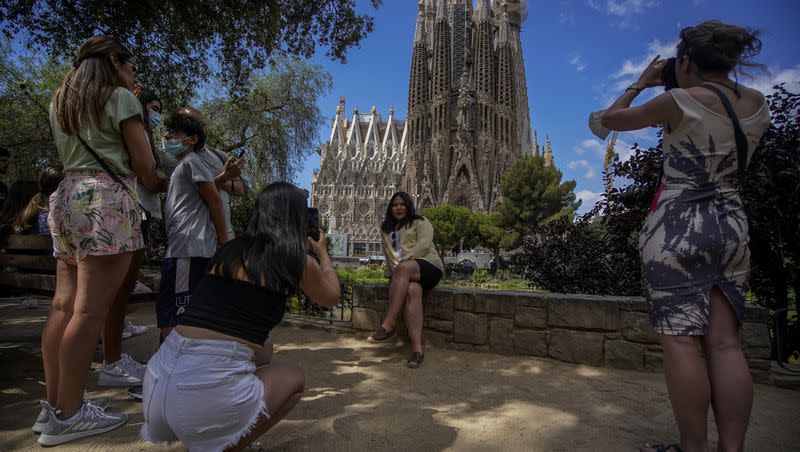La Sagrada Familia nears completion after 141 years

- Oops!Something went wrong.Please try again later.
- Oops!Something went wrong.Please try again later.
- Oops!Something went wrong.Please try again later.
After beginning construction in 1882, Spain’s Sagrada Familia basilica now has 17 of its 18 designed towers fully constructed, per Arch Daily.
The Sagrada Familia Foundation announced on Sept. 27, “Today the final sculptural piece was put on the tower of the Evangelist Matthew, represented by a human figure, and work will continue tomorrow, crowning the tower of the Evangelist John with the figure of the eagle. The crowning of the towers with the figures of the tetramorph representing Matthew and John completes these two towers and, therefore, the group of the towers of the Evangelists.”
Each of the 18 towers is symbolic. Of the 18, 12 represent Christ’s apostles, four represent the Evangelists (Matthew, Mark, Luke and John), one represents the Virgin Mary, and the tallest, central tower represents Jesus Christ, according to Barcelona.com.
Recently, each of the four Evangelist towers were crowned with statues. Matthew was represented by an angel, Mark by a lion, Luke by an ox and John by an eagle, per The Messenger.
Related
When will the Sagrada Familia be finished?
The final tower is predicted to be constructed by 2026, the 100th anniversary commemorating the death of the cathedral’s original architect, Antoni Gaudí, The New York Times reported. Upon completion, the Sagrada Familia will be the world’s tallest church, according to the church’s website.
Why is the Sagrada Familia still not finished?
The Sagrada Familia has not had an easy path to completion, according to Euro News. The first interruption was Gaudí’s accidental death in 1926, when he was hit by a tram. This sudden shock halted the church’s progress for 10 years.
The next delay was due to civil unrest during the Spanish Civil War. Anarchist groups infiltrated the Sagrada Familia, smashed models, burned plans and destroyed the crypt. Further, 12 contributors to the Sagrada Familia’s construction were killed in the war, and progress did not resume until the conflict ended in 1939.
Several decades later, the Spanish government proposed plans for a 39-foot-wide train tunnel, and the proposed location led Sagrada Familia architects to believe “the project could cause irreparable damage” to the church, according to The New York Times.
Alterations to the tunnel were made, construction began in 2010, and “to date, no damage has been reported,” per Artsy.
Who built the Sagrada Familia?
The Sagrada Familia includes a timeline on its website, explaining that architect Francisco de Paula del Villar originally led the project. His plans for the church resembled classically gothic-style cathedrals, but he was reassigned to a different project in 1883.
Gaudí, a Catalan Modernist, was the next chief architect over the church, and ultimately had the most influence on its design. He would work on the project up until his death in 1926 and was buried in the Sagrada Familia’s crypt.
What kind of architecture is the Sagrada Familia?
Architecuul explained, “The style of la Sagrada Familia is variously likened to Spanish Late Gothic, Catalan Modernism and to Art Nouveau or Catalan Noucentisme. While the Sagrada Familia falls within the Art Nouveau period, Nikolaus Pevsner points out that, along with Charles Rennie Macintosh in Glasgow, Gaudí carried the Art Nouveau style far beyond its usual application as a surface decoration.”
What symbolism is there in the Sagrada Familia?
Gaudí said his goal for the Sagrada Familia was for it to be “the Bible made of stone,” per Catalan News.
Sagrada Familia tour guide Onno Schoemaker told Catalan News that due to illiteracy among the Spanish working class during the 19th century, “Gaudí wanted to tell the story of Jesus through imagery, through sculptures and visual elements, rather than through text.”
Through Eternity discusses the Sagrada Familia’s complex symbolism, and says, “The Nativity facade evokes the wonder and joy of Christ’s birth through a focus on organic elements that bring to mind the superabundance and fertility of the natural world. The west-facing Passion facade, on the other hand, reflects the death of Christ through its facing of the setting sun and its spare, unadorned facade.
“At its most general, the massive Sagrada Familia reflects the endless variety and complexity of God’s creation via its dizzying displays of sculptural and spatial virtuosity, a virtual biblical story in stone that is without question the most ambitious and detailed work of Christian architecture of the last 100 years.”
How much are tickets to the Sagrada Familia?
Individual ticket prices range from 26 to 36 euros, but for more specifics, visit the Sagrada Familia’s website.

